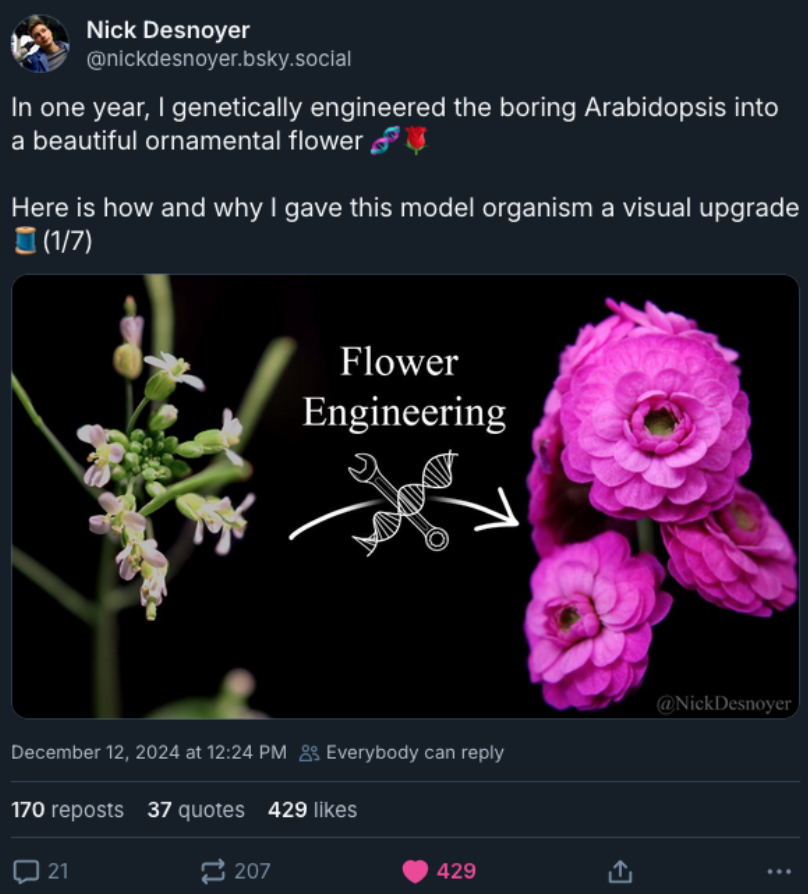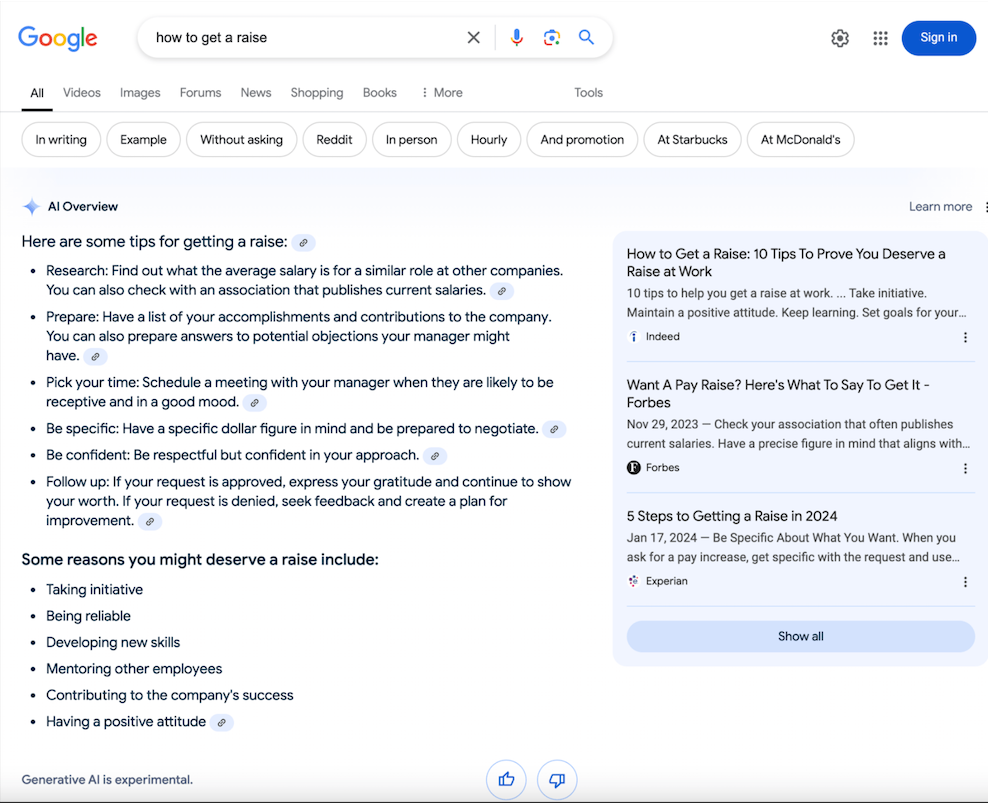If you’re reading this, you might be thinking, “Great, another set of New Year’s predictions that never pan out.”
I get it. Every year, trend articles pop up everywhere, making big promises but rarely delivering insights that feel grounded—or useful. So let’s bring some accountability to the table.
Before jumping into what 2025 might hold for life sciences marketing and communication, I’m revisiting the trends I predicted for 2024. Did they happen? Were they just hype? Was I totally wrong? Let’s find out.
In addition to revisiting them, I will add new details that may influence the coming year in life sciences marketing and communications, and add a few new trends to the list.
Trends I predicted last year
Here are six trends I correctly predicted last year and how they will play out in the year ahead.
1. The rise of AI
Okay, I’ll admit—predicting the rise of AI wasn’t exactly a stroke of genius. By the end of 2023, ChatGPT had already been out for a year, capturing the attention of millions. But what wasn’t immediately obvious was how deeply AI would infiltrate the B2B world, especially in life sciences.
Take, for example, the enzyme and reagents manufacturer Promega, whose use of ChatGPT was recently highlighted by OpenAI itself. Beyond the usual suspects—writing better prospecting emails or summarizing client information—Promega has leveraged ChatGPT as a quick-access database to navigate its vast catalog of products, which to me, seems like a great idea that many companies could replicate.
What’s even more striking is that AI adoption doesn’t show signs of slowing down—it might actually pick up speed in 2025. A survey by management consulting firm ZS, which polled 127 technology executives from multinational biotech, pharma, and life sciences companies, revealed that 93% of them expect increased investments in data, digital, and AI initiatives next year.
But here’s the bigger question: will AI live up to its enormous hype? While AI continues to work its way into nearly every piece of software we use—with varying degrees of success, or usefulness—its true impact remains uncertain. Have we hit a plateau in performance? Or are tools like ChatGPT destined to be little more than glorified auto-correctors?
Time will tell. My guess? 2025 may not feel drastically different from 2024 when it comes to AI. We’ll see incremental improvements, but the groundbreaking leaps many are hoping for might still be on the horizon.
2. The (slow) death of X
A year ago, I predicted that Twitter—rebranded as X—would continue its slow and steady decline into irrelevance. Scientists, a key part of its community, had already started leaving in droves, as Nature reported last year.
I’ll admit, I thought this collapse would happen much faster. But here’s what I didn’t see coming (and, honestly, who did?): the way the 2024 U.S. presidential election would become a turning point for Bluesky, one of Twitter’s new copycats. In just a few weeks following the election, Bluesky exploded in popularity, gaining millions of users daily. As I'm writing this, it’s surpassed 25 million registered users, and by the time you read this article, that number will likely be much higher.

What’s especially interesting is how scientists, who once made Twitter a hub for collaboration and discussion, seem to have found their new home on Bluesky. Many describe it as “a place of joy,” a stark contrast to the toxicity that drove them away from X.
Just take a look at the post below. If you have even the slightest interest in science, you’re going to find it absolutely fascinating:

I’ve joined the Bluesky bandwagon myself over the past few weeks, and I have to say—it’s been a breath of fresh air. It feels like the Twitter of the 2010s: lighthearted, engaging, and full of value. The conversations are down to earth, the people are fun, and the platform favors sharing interesting links, which, for me, is the best part of any social network.
Last year, I predicted LinkedIn would emerge as the real winner in Twitter’s decline. But now, I’m rethinking that call. If Bluesky continues on this path, it might just become the go-to platform for scientists in 2025.
3. Events are back, and still an ineffective strategy
In 2023, I wrote about how physical events were roaring back to life in the life sciences industry after the pandemic. The appetite for face-to-face meetings was undeniable, with record-breaking attendance at BIO-Europe in Munich serving as proof.
As 2024 comes to a close, it seems that we’re basically back to a pre-pandemic situation when it comes to events. Take the BIO International Convention, the largest biotech event in the world. Attendance figures paint a clear picture of the post-pandemic rebound:
- 2018: 18,289 attendees
- 2019: 15,858 attendees
- 2020: 17,000 (fully virtual due to COVID-19)
- 2021: Numbers weren’t disclosed but likely very low.
- 2022: 10,000 attendees as the industry tentatively returned to in-person events.
- 2023: A remarkable 20,559 participants—a clear sign of recovery.
- 2024: Over 19,500 attendees, slightly below 2023 but still impressive.
But here’s the thing: while the energy is back, the strategy often isn’t. It’s not enough to simply show up with a booth and some glossy brochures. Much of the investment in event marketing in life sciences remains painfully inefficient.
Here’s the fix: adopt a data-driven mindset for events. Ensure your event efforts align with your ideal customer profile, focus on engagement, not foot traffic, and use post-event data to assess whether your leads convert and refine your approach for the next time.
Life sciences marketers have the opportunity to turn these gatherings into high-value lead conversion mechanics. The question is, will they adapt? Or will they keep relying on outdated tactics? On this point, I’m still quite pessimistic.
4. SEO is a mess
Last year, I predicted that generative AI integration to search would disrupt SEO and significantly impact web traffic. That forecast has proven accurate, especially with Google’s rollout of its AI Overview at the top of search results.
Google officially launched AI Overviews in the U.S. on May 14, 2024, and expanded them to six more countries—UK, India, Japan, Indonesia, Mexico, and Brazil—just three months later. These AI Overviews are automatically generated summaries of search queries that dominate the space above the fold on search results pages:

As you can see in the image, the AI Overview takes up the best spot on the page and pulls most of the searcher’s attention. Sure, it includes links to sources, but they’re pretty low-key and easy to miss.
The impact on web traffic is even more concerning. A study of 1,675 non-branded keywords in the US found that websites cited in Google’s AI Overviews received 8.9% fewer clicks. In contrast, websites not cited saw a smaller decline of 2.8%. Ironically, being featured in the AI Overview may deter users from clicking through because they trust the summary and feel no need to verify the source.
If you think this is the peak of the disruption, brace yourself. Google CEO Sundar Pichai recently hinted at more transformative changes ahead in an interview:
“We are in the earliest stages of a profound shift… I think we’ll be surprised even early in 2025, the kind of newer things search can do compared to where it is today”.
So yes, SEO is a mess right now because it’s in total transformation. However, one principle remains unchanged: focus on producing valuable content based on genuine expertise but also keep in mind that diversifying your traffic sources might be important in the future. Search traffic is becoming increasingly unpredictable, and relying too heavily on it could be risky for your brand.
5. You are still not getting TikTok
TikTok might seem like a tempting platform for marketing, given its massive user base and viral potential, but for the life sciences industry, it’s not the best fit—especially as we head into 2025.
Last year, I already showed how creating branded content for the platform is a potential recipe for backlash (because of the expectation of the audience and their age), but now the platform's future is increasingly uncertain.
One of the biggest issues is the geopolitical tension surrounding TikTok. In markets like the U.S. and Europe, concerns over data privacy and national security have led to calls for stricter regulations or outright bans. For life sciences companies, which already operate under strict compliance and regulatory requirements, investing time and resources into a platform with such instability could be a risky bet.
I'm not saying you shouldn't try it, or keep using it if it works for you, but in my opinion, now is not a good time to invest in it. Wait at least a few months for the ban situation to clear up. Also, consider my next point, which is a less risky way to use the platform's potential.
6. Influencer marketing has taken off
I’m quite bullish about using influencers to promote science-related products. Last year, I pointed out that this trend was gaining traction in B2B, and it’s only grown since.
Earlier this year, I even wrote an article on “the rise of patients influencers” where I explored how more and more pharma companies are leveraging their own patients to promote therapies (which, by the way, is legal in the U.S.).
To be clear, I don't support the idea of promoting drugs through social media influencers (that could be my European sensibility, or just having some ethics). But I genuinely believe influencers could play a bigger role in marketing other science-related technologies—like lab equipment. Scientists are active on social media, and when someone they follow shares tech they actually use, it can be incredibly persuasive.
I haven’t come across standout examples of this yet, but it feels like a huge missed opportunity for a lot of brands. So, if you are an adventurer in the marketing world, it might be worth exploring this option in 2025.
Trends I totally got wrong
I'm no Nostradamus, so I can get a few things wrong. Here are three predictions I got wrong (or overestimated) last year.
7. Marketers still struggle with email marketing and newsletters
Last year, I was optimistic about the rise of niche newsletters in life sciences marketing. I still believe they offer a unique opportunity to reach highly engaged and specialized audiences at a relatively low cost. However, as 2024 unfolded, it became clear that this trend hadn’t gained the momentum I expected. So, where did I go wrong?
First, niche newsletters may be attractive on paper, but breaking through the clutter to make them a worthwhile promotion channel is challenging. Many companies likely hesitate to invest in a space that requires significant effort to maintain and grow.
Second, I also thought marketers could take advantage of the expanding collection of niche newsletters appearing online to advertise with them, but I underestimated how cautious life sciences companies are when experimenting with new marketing channels. Advertising in niche newsletters is still an unproven tactic for many marketers in this industry, add to that the time and effort required to find the right newsletters and negotiate ad placements, and it’s easy to see why marketers may have opted for safer, more predictable strategies.
In hindsight, while the potential of niche newsletters is still there, the reality is that they require more work to integrate into a marketing strategy than I originally anticipated. For the trend to take off, the industry may need more proof of success, or just more time. Until then, it remains an underutilized opportunity, but one that hasn’t quite lived up to its promise.
8. Podcasts are still an underused media
Last year, I predicted that life sciences companies would rush into the podcast medium in order to get closer to healthcare providers and patients.
While I was not totally wrong, I may have been a bit too enthusiastic about it. I initially got excited by this format when I saw that Argenx’s podcast series focusing on a rare disease called Myasthenia Gravis managed to count over 100,000 downloads. For me, this was a clear sign of the potential of hyper-niche podcasts in healthcare.
But despite some interesting initiatives, it seems that podcasts still have a big potential that is not exploited. Earlier this year, a report by CMI Media Group and Compas reported that “21% of healthcare professionals consider podcasts very/extremely important resources to stay abreast of medical developments and treatment options”, which shows how much healthcare providers, and thus their patients, can be influenced by a podcast.
I’m still enthusiastic, though, and there are some good examples of podcasts that aired this year, like “Birth of a Biotech Podcast” from the biotech startup Belharra Therapeutics. In this 7-episode limited series, the founders of Belharra tell the story of how they went from postdocs at Scripps Research to founding a biotech startup that eventually went out of stealth with $130 million in funding and a deal with Genentech. It’s a rare account of how biotech companies are founded, and an excellent branding asset this company can use to attract talents, investors and potential partners.
In a more indirect way, Japanese pharma company Eisai has also added a podcast to its growing stable. The podcast “Rethinking Alzheimer's Disease”, produced by a third-party podcast studio and sponsored by Eisai, focuses on the life of Alzheimer’s disease patients and their journey from diagnosis to living with the condition.
This form of podcast production is much less riskier than directly attaching the brand to the show, and also helps with credibility as it keeps the sponsor out of the content production. A good inspiration for other marketers.
9. Life sciences still has a long way to go when it comes to automation
Last year, I was optimistic about marketing automation reaching new heights, thanks to tools like Zapier and the growing integration of AI, particularly with ChatGPT. I believe this combination would make automation more accessible, transforming how marketers handle repetitive tasks. While the potential is undeniable, I now think I overestimated how quickly this trend would take off—especially in industries like life sciences.
One of the main barriers is the maturity of AI agents. While tools like Zapier and ChatGPT are powerful, they still rely heavily on user input and guidance and are far from the promised autonomous agents touted by the AI industry.
Another factor is the cautious nature of marketers in life sciences. Automation tools may promise efficiency, but their adoption often requires a cultural shift. Many marketers are still hesitant to automate key workflows, fearing loss of control or potential compliance risks. This hesitation is compounded by the learning curve associated with integrating tools like Zapier into existing systems. While automation has become easier, it’s not yet "plug and play" for most businesses, especially those managing complex and sensitive data.
Until we see safer, more intuitive AI agents that can work seamlessly within existing tech stacks, automation will remain more of a "nice-to-have" than a "must-have" for many.
New trends for 2025
To wrap up this series of predictions, let's explore two new ones that I think could influence the way we do life sciences marketing in the coming year.
10. Chinese CROs will rebrand
Thanks to the Biosecure Act, which aims to reduce Western dependence on Chinese suppliers for sensitive biotech and pharmaceutical services, Chinese CROs are being forced to rethink their global strategies—and rebranding has emerged as a key move.
CRO giant WuXi Apptec, which helped commercialize one-fourth of the drugs in the U.S., is particularly in the spotlight of the Biosecure Act. For example, WuXi NextCODE recently rebranded as Genuity Science, a move that coincided with shedding its Shanghai operations to focus on U.S. and European markets. WuXi Advanced Therapies is also considering selling off assets in response to mounting pressures.
For Chinese CROs, removing their ties to China or emphasizing a Westernized identity could be the only way to maintain market shares. Meanwhile, Western players are seizing the chance to fill the void.
For marketers and business leaders, this trend highlights the need to keep a close eye on geopolitical influences in the life sciences supply chain. Companies that can adapt quickly—whether through rebranding, acquisitions, or strategic partnerships—will emerge stronger in this reshaped market.
11. Life science companies will take sustainability more seriously
In 2025, life sciences companies will be under increasing pressure to prioritize sustainability, and this shift is already underway. Thermo Fisher, for example, is focusing on "greener by design" principles to reduce its environmental impact. They aim to minimize hazardous materials, use fewer resources, and develop energy-efficient products.
As scientists demand more environmentally conscious products in the lab, life sciences firms will have to adapt to stay competitive. For marketers, it might become a strong competitive advantage worth exploring.
What to expect from 2025?
As always, predictions are best used as a guide or a way to stimulate new ideas, rather than as a strict law to be followed. Some may not even apply to your specific business, so it’s wise to take them with a pinch of salt.
What really matters this year is that marketers continue to explore and test new approaches. After all, experimentation is at the heart of marketing. And in life sciences, where many of us come from scientific backgrounds, it’s even more crucial.
So keep experimenting, dear science marketers!






